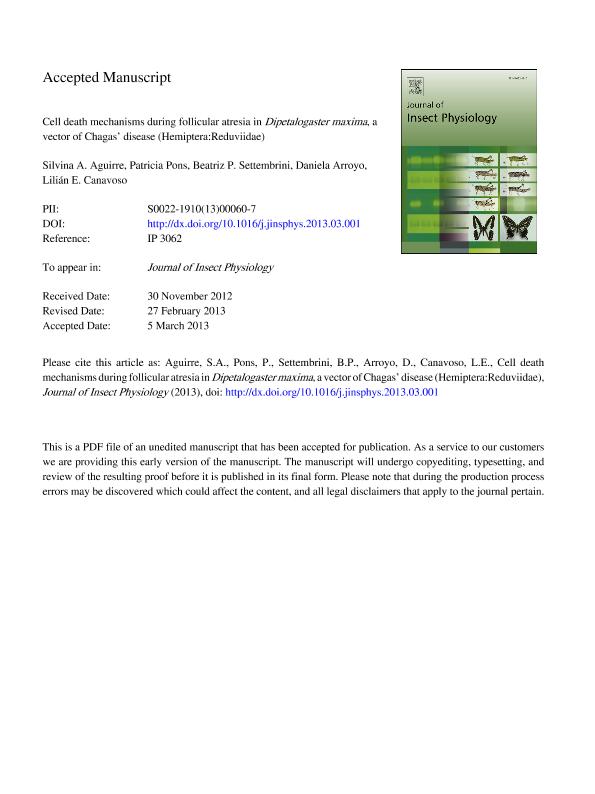Artículo
Cell death mechanisms during follicular atresia in Dipetalogaster maxima, a vector of Chagas' disease (Hemiptera: Reduviidae)
Aguirre, Silvina Andrea ; Pons, Patricia; Settembrini, Beatriz Patricia
; Pons, Patricia; Settembrini, Beatriz Patricia ; Arroyo, Daniela Soledad
; Arroyo, Daniela Soledad ; Canavoso, Lilian Etelvina
; Canavoso, Lilian Etelvina
 ; Pons, Patricia; Settembrini, Beatriz Patricia
; Pons, Patricia; Settembrini, Beatriz Patricia ; Arroyo, Daniela Soledad
; Arroyo, Daniela Soledad ; Canavoso, Lilian Etelvina
; Canavoso, Lilian Etelvina
Fecha de publicación:
05/2013
Editorial:
Pergamon-Elsevier Science Ltd
Revista:
Journal of Insect Physiology
ISSN:
0022-1910
Idioma:
Inglés
Tipo de recurso:
Artículo publicado
Clasificación temática:
Resumen
In this work wehave analyzed the involvement of cell death pathways during the process of follicular atresia in the hematophagous insect vector Dipetalogaster maxima. Standardized insect rearing conditions were established to induce agradual follicular degeneration stage bydepriving females ofblood meal during post-vitellogenesis. Wefirstcharacterized the morpho-histological and ultrastructural changes of the ovarian tissue at early and late follicular atresia by light and transmission electron microscopy. Apoptosis was investigated by DAPI nuclear staining, TUNEL labeling and the detection ofactive caspase-3 by immunofluorescence. Autophagy was assessed bythe measurement ofacid phosphatase activ- ity in ovarian homogenates and monitor edbythe detection ofthe specificmarker ofautophagic compartments, LC3. High levels of acid phosphatase activity were detected at all atretic stages. However, follicular cells of follicles undergoing incipient degeneration in early atresia exhibited features of apoptosis such as chromatin condensation,DNA fragmentation and the presence of active caspase-3. The ultrastructural findings and the increased levels of LC3-II found at late follicular atresia supported the relevance of autophagy at this atretic stage, although the extent of autophagosome formation demonstrated that this cell death pathway also occurred at early atresia. In late atresia,follicular cells also displayed more drastic changes compatible with necrosis. Taken together, results showed that apoptosis, autophagy and necrosis were operative during follicular atresia in D. maxima. Moreover, it was shown that the relevance of these cell death mechanisms correlate swith the time elapsed since the onset of the degenerative process.
Palabras clave:
DIPETALOGASTER MAXIMA
,
REPRODUCTION
,
FOLLICULAR ATRESIA
,
APOPTOSIS
,
AUTOPHAGY
Archivos asociados
Licencia
Identificadores
Colecciones
Articulos(CIBICI)
Articulos de CENTRO DE INV.EN BIOQUI.CLINICA E INMUNOLOGIA
Articulos de CENTRO DE INV.EN BIOQUI.CLINICA E INMUNOLOGIA
Articulos(MACNBR)
Articulos de MUSEO ARG.DE CS.NAT "BERNARDINO RIVADAVIA"
Articulos de MUSEO ARG.DE CS.NAT "BERNARDINO RIVADAVIA"
Citación
Aguirre, Silvina Andrea; Pons, Patricia; Settembrini, Beatriz Patricia; Arroyo, Daniela Soledad; Canavoso, Lilian Etelvina; Cell death mechanisms during follicular atresia in Dipetalogaster maxima, a vector of Chagas' disease (Hemiptera: Reduviidae); Pergamon-Elsevier Science Ltd; Journal of Insect Physiology; 59; 5-2013; 532-541
Compartir
Altmétricas



